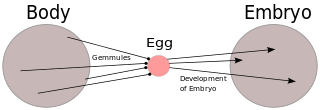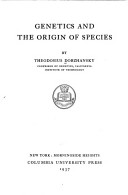
Genetics is a branch of biology concerned with the study of genes, genetic variation, and heredity in organisms.

Gregor Johann Mendel was a meteorologist, mathematician, biologist, Augustinian friar and abbot of St. Thomas' Abbey in Brno, Margraviate of Moravia. Mendel was born in a German-speaking family in the Silesian part of the Austrian Empire and gained posthumous recognition as the founder of the modern science of genetics. Though farmers had known for millennia that crossbreeding of animals and plants could favor certain desirable traits, Mendel's pea plant experiments conducted between 1856 and 1863 established many of the rules of heredity, now referred to as the laws of Mendelian inheritance.

Heredity, also called inheritance or biological inheritance, is the passing on of traits from parents to their offspring; either through asexual reproduction or sexual reproduction, the offspring cells or organisms acquire the genetic information of their parents. Through heredity, variations between individuals can accumulate and cause species to evolve by natural selection. The study of heredity in biology is genetics.

Pangenesis was Charles Darwin's hypothetical mechanism for heredity, in which he proposed that each part of the body continually emitted its own type of small organic particles called gemmules that aggregated in the gonads, contributing heritable information to the gametes. He presented this 'provisional hypothesis' in his 1868 work The Variation of Animals and Plants Under Domestication, intending it to fill what he perceived as a major gap in evolutionary theory at the time. The etymology of the word comes from the Greek words pan and genesis ("birth") or genos ("origin"). Pangenesis mirrored ideas originally formulated by Hippocrates and other pre-Darwinian scientists, but built off of new concepts such as cell theory, explaining cell development as beginning with gemmules which were specified to be necessary for the occurrence of new growths in an organism, both in initial development and regeneration. It also accounted for regeneration and the Lamarckian concept of the inheritance of acquired characteristics, as a body part altered by the environment would produce altered gemmules. This made Pangenesis popular among the neo-Lamarckian school of evolutionary thought. This hypothesis was made effectively obsolete after the 1900 rediscovery among biologists of Gregor Mendel's theory of the particulate nature of inheritance.

Theodosius Grygorovych Dobzhansky was a prominent Ukrainian-American geneticist and evolutionary biologist, and a central figure in the field of evolutionary biology for his work in shaping the modern synthesis. Dobzhansky was born in Ukraine, then part of the Russian Empire, and became an immigrant to the United States in 1927, aged 27.

Sir Ronald Aylmer Fisher was a British statistician, geneticist, and academic. For his work in statistics, he has been described as "a genius who almost single-handedly created the foundations for modern statistical science" and "the single most important figure in 20th century statistics". In genetics, his work used mathematics to combine Mendelian genetics and natural selection; this contributed to the revival of Darwinism in the early 20th-century revision of the theory of evolution known as the modern synthesis. For his contributions to biology, Fisher has been called "the greatest of Darwin’s successors".
Lamarckism, also known as Lamarckian inheritance or neo-Lamarckism, is the notion that an organism can pass on to its offspring physical characteristics that the parent organism acquired through use or disuse during its lifetime. It is also called the inheritance of acquired characteristics or more recently soft inheritance. The idea is named after the French zoologist Jean-Baptiste Lamarck (1744–1829), who incorporated the classical era theory of soft inheritance into his theory of evolution as a supplement to his concept of orthogenesis, a drive towards complexity.

The Genetical Theory of Natural Selection is a book by Ronald Fisher which combines Mendelian genetics with Charles Darwin's theory of natural selection, with Fisher being the first to argue that "Mendelism therefore validates Darwinism" and stating with regard to mutations that "The vast majority of large mutations are deleterious; small mutations are both far more frequent and more likely to be useful", thus refuting orthogenesis. First published in 1930 by The Clarendon Press, it is one of the most important books of the modern synthesis, and helped define population genetics. It is commonly cited in biology books, outlining many concepts that are still considered important such as Fisherian runaway, Fisher's principle, reproductive value, Fisher's fundamental theorem of natural selection, Fisher's geometric model, the sexy son hypothesis, mimicry and the evolution of dominance. It was dictated to his wife in the evenings as he worked at Rothamsted Research in the day.

William Bateson was an English biologist who was the first person to use the term genetics to describe the study of heredity, and the chief populariser of the ideas of Gregor Mendel following their rediscovery in 1900 by Hugo de Vries and Carl Correns. His 1894 book Materials for the Study of Variation was one of the earliest formulations of the new approach to genetics.

Genetics and the Origin of Species is a 1937 book by the Ukrainian-American evolutionary biologist Theodosius Dobzhansky. It is regarded as one of the most important works of the modern synthesis, and was one of the earliest. The book popularized the work of population genetics to other biologists, and influenced their appreciation for the genetic basis of evolution. In his book, Dobzhansky applied the theoretical work of Sewall Wright (1889–1988) to the study of natural populations, allowing him to address evolutionary problems in a novel way during his time. Dobzhansky implements theories of mutation, natural selection, and speciation throughout his book to explain habits of populations and the resulting effects on their genetic behavior. The book explains evolution in depth as a process over time that accounts for the diversity of all life on Earth. The study of evolution was present, but greatly neglected at the time. Dobzhansky illustrates that evolution regarding the origin and nature of species during this time in history was deemed mysterious, but had expanding potential for progress to be made in its field.
Alfred Henry Sturtevant was an American geneticist. Sturtevant constructed the first genetic map of a chromosome in 1911. Throughout his career he worked on the organism Drosophila melanogaster with Thomas Hunt Morgan. By watching the development of flies in which the earliest cell division produced two different genomes, he measured the embryonic distance between organs in a unit which is called the sturt in his honor. In 1967, Sturtevant received the National Medal of Science.

The history of genetics dates from the classical era with contributions by Pythagoras, Hippocrates, Aristotle, Epicurus, and others. Modern genetics began with the work of the Augustinian friar Gregor Johann Mendel. His work on pea plants, published in 1866, established the theory of Mendelian inheritance.

Robert Heath Lock was an English botanist and geneticist who wrote the first English textbook on genetics.

This bibliography of biology is a list of notable works, organized by subdiscipline, on the subject of biology.
Robert H. Tamarin is a biologist and author. He authored the principles of genetics, a textbook in its seventh edition with McGraw-Hill Publishers. His research interest focuses on evolutionary genetics. He has also developed radioisotope, electrophoretic and DNA fingerprinting techniques for use in the study of small mammal.

Robert "Bob" Wayne Allard was an American plant breeder and plant population geneticist who is widely regarded as one of the leading plant population geneticists of the 20th century. Allard became Chair of the Genetics Department at University of California, Davis in 1967; he was elected to the National Academy of Sciences in 1973, and was awarded the DeKalb-Pfizer Distinguished Career Award and the Crop Science Science of America Award. He was honored as the Nilsson-Ehle Lecturer of the Mendelian Society of Sweden and as the Wilhelmine Key lecturer of the American Genetic Association. He also served as president of the Genetics Society of America, the American Genetic Association and the American Society of Naturalists.
Genetics Research is an open access, peer-reviewed scientific journal covering all aspects of human and animal genetics, reporting key findings on genomes, genes, mutations and molecular interactions, extending out to developmental, evolutionary, and population genetics as well as ethical, legal and social aspects. It was established in 1960 as Genetical Research, obtaining its current name in 2008. The founding editor-in-chief was Eric C.R. Reeve.

A Treatise on the Analytical Dynamics of Particles and Rigid Bodies is a treatise and textbook on analytical dynamics by British mathematician Sir Edmund Taylor Whittaker. Initially published in 1904 by the Cambridge University Press, the book focuses heavily on the three-body problem and has since gone through four editions and has been translated to German and Russian. Considered a landmark book in English mathematics and physics, the treatise presented what was the state-of-the-art at the time of publication and, remaining in print for more than a hundred years, it is considered a classic textbook in the subject. In addition to the original editions published in 1904, 1917, 1927, and 1937, a reprint of the fourth edition was released in 1989 with a new foreword by William Hunter McCrea.
Ernest "Ernie" Robert Sears was an American geneticist, botanist, pioneer of plant genetics, and leading expert on wheat cytogenetics. Sears and Sir Ralph Riley (1924–1999) are perhaps the two most important founders of chromosome engineering in plant breeding.

Principles of Optics, colloquially known as Born and Wolf, is an optics textbook written by Max Born and Emil Wolf that was initially published in 1959 by Pergamon Press. After going through six editions with Pergamon Press, the book was transferred to Cambridge University Press who issued an expanded seventh edition in 1999. A 60th anniversary edition was published in 2019 with a foreword by Sir Peter Knight. It is considered a classic science book and one of the most influential optics books of the twentieth century.













